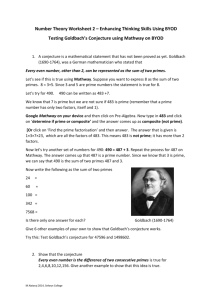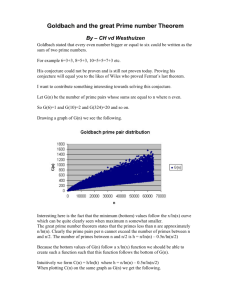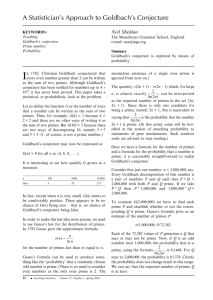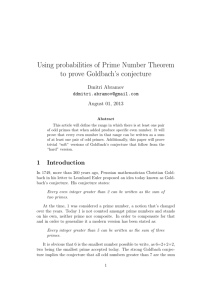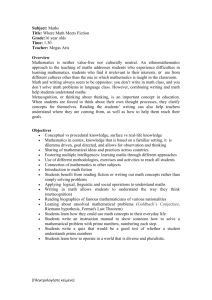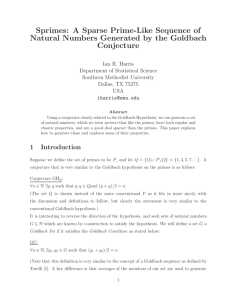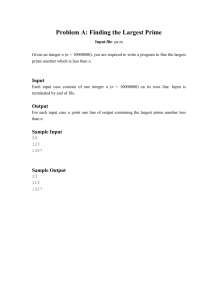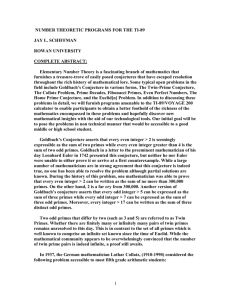A Reformulation of the Goldbach Conjecture
advertisement
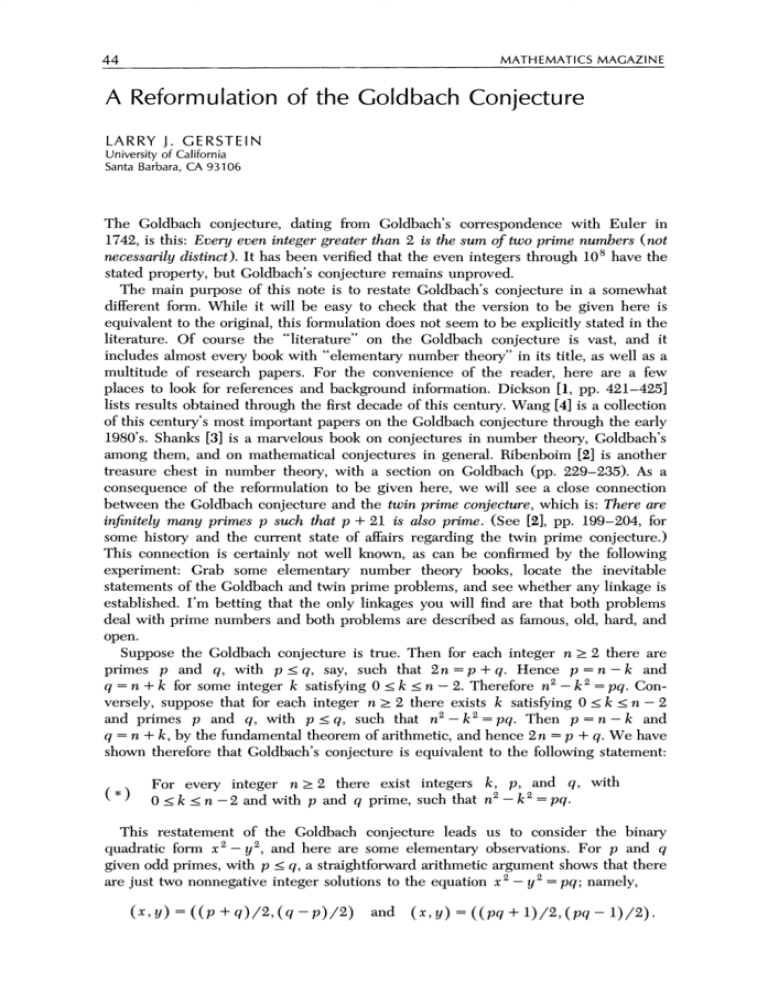
44
MATHEMATICS MAGAZINE
A Reformulation of the Goldbach Conjecture
L A R R Y J . GERSTEIN
University of California
Santa Barbara, CA 93106
The Goldbach conjecture, dating from Goldbach's correspondence with Euler in
1742, is this: Every even integer greater than 2 is the sum of two prime numbers (not
necessarily distinct). It has been verified that the even integers through 10' have the
stated property, but Goldbach's conjecture remains unproved.
The main purpose of this note is to restate Goldbach's conjecture in a somewhat
different form. While it will be easy to check that the version to be given here is
equivalent to the original, this formulation does not seem to be explicitly stated in the
literature. Of course the "literature" on the Goldbach conjecture is vast, and it
includes almost every book with "elementary number theory" in its title, as well as a
multitude of research papers. For the convenience of the reader, here are a few
places to look for references and background information. Dickson [I, pp. 421-4251
lists results obtained through the first decade of this century. Wang [4] is a collection
of this century's most important papers on the Goldbach conjecture through the early
1980's. Shanks [3] is a marvelous book on conjectures in number theory, Goldbach's
among them, and on mathematical conjectures in general. Ribenboim [2] is another
treasure chest in number theory, with a section on Goldbach (pp. 229-235). As a
consequence of the reformulation to be given here, we will see a close connection
between the Goldbach conjecture and the twin prime conjecture, which is: There are
infinitely many primes p such that p 21 is also prime. (See [2], pp. 199-204, for
some history and the current state of affairs regarding the twin prime conjecture.)
This connection is certainly not well known, as can be confirmed by the following
experiment: Grab some elementary number theory books, locate the inevitable
statements of the Goldbach and twin prime problems, and see whether any linkage is
established. I'm betting that the only linkages you will find are that both problems
deal with prime numbers and both problems are described as famous, old, hard, and
open.
Suppose the Goldbach conjecture is true. Then for each integer n 2 2 there are
primes p and q , with p I q , say, such that 2n = p q. Hence p = n - k and
q = n k for some integer k satisfying 0 _< k _< n - 2. Therefore n2 - k = pq. Conversely, suppose that for each integer n 2 2 there exists k satisfying 0 _< k _< n - 2
and primes p and q , with p _< q , such that n2 - k 2 = pq. Then p = n - k and
q = n k , by the fundamental theorem of arithmetic, and hence 2n = p q. We have
shown therefore that Goldbach's conjecture is equivalent to the following statement:
+
+
+
(*)
+
+
For every integer n 2 2 there exist integers k , p, and q , with
01k_<n-2andwithpandqprime,suchthatn"k~=~q.
This restatement of the Goldbach conjecture leads us to consider the binary
quadratic form x2 - Y 2 , and here are some elementary observations. For p and q
given odd primes, with p I
q , a straightforward arithmetic argument shows that there
are just two nonnegative integer solutions to the equation x 2 - Y 2 = pq; namely,
VOL. 66, NO. 1, FEBRUARY 1 9 9 3 45
On the other hand, there are infinitely many rational solutions. In fact, if
for all A E Q* we have
P
E
Q* =
Q - {0), then
For the Goldbach conjecture we need to work in the opposite direction; that is, we
consider the values of x2 - y 2 when x = n is fixed and y varies in Z,and we look for
appropriate primes p and q.
Whether or not ( T ) is true, it is intriguing to ask how often k = 1 works in ( * ) and
to make the following conjecture:
There are infinitely many integers n 2 2 for which there exist primes p
( * * > and q such that n2 - 1 = pq.
Statement ( * * ) is clearly equivalent to the twin prime conjecture. Thus, while the
Goldbach and twin prime conjectures are not the same, they are evidently facets of
the same jewel.
REFERENCES
1. Leonard E. Dickson, History of the Theory of Numbers, Vol. 1, Chelsea Publishing Co., New York, 1971.
2. Paulo Ribenboim, The Book of Prime Number Records, 2nd edition, Springer-Verlag Inc., New York,
1989.
3. Daniel Shanks, Solved and Unsolved Problems in Number Theory, 3rd edition, Chelsea Publishing Co.,
New York, 1985.
4. Wang Yuan (Editor), Goldbach Conjecture, World Scientific Publishing Co., Singapore, 1984.
A Lesser-Known Goldbach Conjecture
L A U R E N T HODGES
Iowa State University
Ames, IA 5001 1
In Example 64 of his recent article [ l ] ,R. K. Guy asked about the representations of
odd positive integers as sums of a prime and twice a square, mentioning that
Ruemmler had found the first exception to be 5777 and wondered if it might be the
last.
This problem has a long history, beginning with Christian Goldbach, best known
for his 1742 conjecture that every even integer can be represented as the sum of two
primes. In the last paragraph of a letter to Leonhard Euler dated 18 November 1752,
Goldbach expressed his belief that every odd integer could be written in the form
p 2a2, where p is a prime (or 1, then considered a p i m e ) and a 2 0 is an integer
[2, p. 5941. Writing in his usual mixture of German and Latin, Goldbach said:
+
Noch habe ein kleines ganz neues theorema beyzufiigen, welches so lange
vor wahr halte, donec probetur contrarium: Omnis numerus impar est =
duplo quadrati numero primo, sive 2 n - 1 = 2aa p , ubi a denotet
17,
numerum integrum vel 0, p numerum primum, ex. gr. 17 = 2
21 = 2.1'
19, 27 = 2.2'
19, etc.
+
+
+
+
SO'
+

